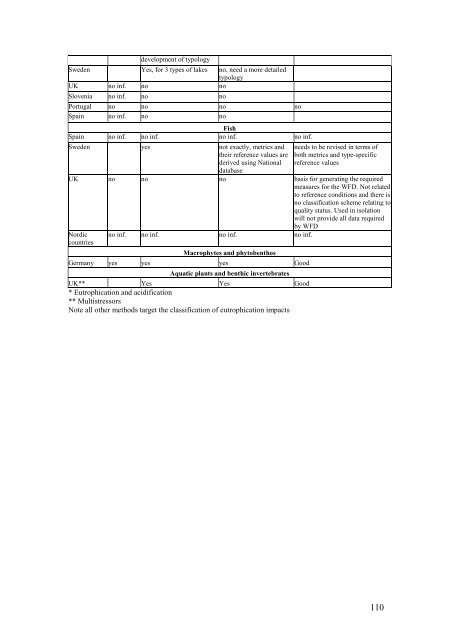Report on Harmonisation of freshwater biological methods
Report on Harmonisation of freshwater biological methods Report on Harmonisation of freshwater biological methods
development of typologySweden Yes, for 3 types of lakes no, need a more detailedtypologyUK no inf. no noSlovenia no inf. no noPortugal no no no noSpain no inf. no noFishSpain no inf. no inf. no inf. no inf.Sweden yes not exactly, metrics andtheir reference values arederived using Nationaldatabaseneeds to be revised in terms ofboth metrics and type-specificreference valuesUK no no no basis for generating the requiredmeasures for the WFD. Not relatedto reference conditions and there isno classification scheme relating toquality status. Used in isolationwill not provide all data requiredby WFDNordiccountriesno inf. no inf. no inf. no inf.Macrophytes and phytobenthosGermany yes yes yes GoodAquatic plants and benthic invertebratesUK** Yes Yes Good* Eutrophication and acidification** MultistressorsNote all other methods target the classification of eutrophication impacts110
Annex IX: WFD Common Metric1. In order to ensure comparability of the Ecological Quality Ratio (EQR) scalesbetween the different EU countries and to obtain a common understanding of thegood ecological status of surface waters all over EU, the WFD requires for theintercalibration of the classification results of the biological monitoring systems. Inpractice, the intercalibration exercise must establish the values for the boundarybetween the classes of high and good status, and for the boundary between good andmoderate status, which shall be consistent with the normative definitions of thoseclass boundaries given in Annex V of the WFD.2. As in the WFD the intercalibration is a two-phase process, which starts with theestablishment of an intercalibration network consisting of sites representing theboundaries between the quality classes ‘High-Good’ and ‘Good-Moderate’, as basedon the WFD normative definitions. In a second phase each Member State’sassessment method must be calibrated both in the ecoregion and for the surface watertype to which the system is applicable. The results of the second phase must be usedto set (EQR) values for relevant class boundaries for each Member States biologicalassessment system.3. The intercalibration exercise will focus on specific type/biological qualityelement/ pressure combinations, which were selected based in data availability withinthe time constrains of the exercise. For rivers, the intercalibration will focus on sitesimpacted by organic and/or nutrient loading, river modification and acidification asassessed making use of macroinvertebrates, fish and benthic algae. For lakes, thefocus will be on eutrophication and acidification as assessed using, respectively, ofphytoplankton and macrophytes, and macroinvertebrates and fish respectively. Thedifferent combinations of pressures/ biological quality elements are, both for river andlakes, dependant of the GIG, the pressure and the type.4. Guidance on the intercalibration process was developed within a drafting groupthat is part of the ECOSTAT WG 2A. The guidance foresees an intercalibrationprocess based in the selection from three different options, and several hybrids ofthese options, all firmly based on the definition of a protocol for deriving goodecological status class boundary values from the normative definitions. The choice of111
- Page 59 and 60: Plants sampled per GIG1008060%40Eme
- Page 61 and 62: NO qualitativ method species number
- Page 63 and 64: indicators, species lists, frequenc
- Page 65 and 66: 26. The sampling frequency is varia
- Page 67: CEN/TC 230/WG 2/ TG 4 N28, 2 nd wor
- Page 70 and 71: programs are based only on the diat
- Page 72 and 73: 21. Some countries like France, Est
- Page 74 and 75: Table 1. European methods for monit
- Page 76 and 77: countries also covers Non-EU Member
- Page 78 and 79: 49. The Danish Stream Fauna Index i
- Page 80 and 81: Hungary58. Since 2002 a modificatio
- Page 82 and 83: Acidification Index, based on the s
- Page 84 and 85: Identification is predominantly to
- Page 86 and 87: size of the net range between 250 t
- Page 88 and 89: water bug genus (Aphelocheirus) and
- Page 90 and 91: Table 5. Common abundance classific
- Page 92 and 93: 108. Process Assessment focuses on
- Page 94 and 95: Austria120. MuLFA: Ecological Integ
- Page 96 and 97: Sweden126. Swedish fish Index: Appe
- Page 98 and 99: ut comparisons have been made with
- Page 100 and 101: seasons for sampling are summer and
- Page 102 and 103: 102
- Page 104 and 105: Consultation open to ECOSTAT &inter
- Page 106 and 107: Table 1. List of European standards
- Page 108 and 109: 108
- Page 112 and 113: one or other option depends on the
- Page 114 and 115: 114
- Page 116 and 117: • An integrated holistic evaluati
- Page 118 and 119: • Phytoplankton: Yes; Clorophyll
- Page 120 and 121: • Macroalgae: No• Benthic inver
- Page 122 and 123: • Macrophytes: No• Macroalgae:
- Page 124: Mission of the JRCThe mission of th
development <strong>of</strong> typologySweden Yes, for 3 types <strong>of</strong> lakes no, need a more detailedtypologyUK no inf. no noSlovenia no inf. no noPortugal no no no noSpain no inf. no noFishSpain no inf. no inf. no inf. no inf.Sweden yes not exactly, metrics andtheir reference values arederived using Nati<strong>on</strong>aldatabaseneeds to be revised in terms <strong>of</strong>both metrics and type-specificreference valuesUK no no no basis for generating the requiredmeasures for the WFD. Not relatedto reference c<strong>on</strong>diti<strong>on</strong>s and there isno classificati<strong>on</strong> scheme relating toquality status. Used in isolati<strong>on</strong>will not provide all data requiredby WFDNordiccountriesno inf. no inf. no inf. no inf.Macrophytes and phytobenthosGermany yes yes yes GoodAquatic plants and benthic invertebratesUK** Yes Yes Good* Eutrophicati<strong>on</strong> and acidificati<strong>on</strong>** MultistressorsNote all other <strong>methods</strong> target the classificati<strong>on</strong> <strong>of</strong> eutrophicati<strong>on</strong> impacts110



